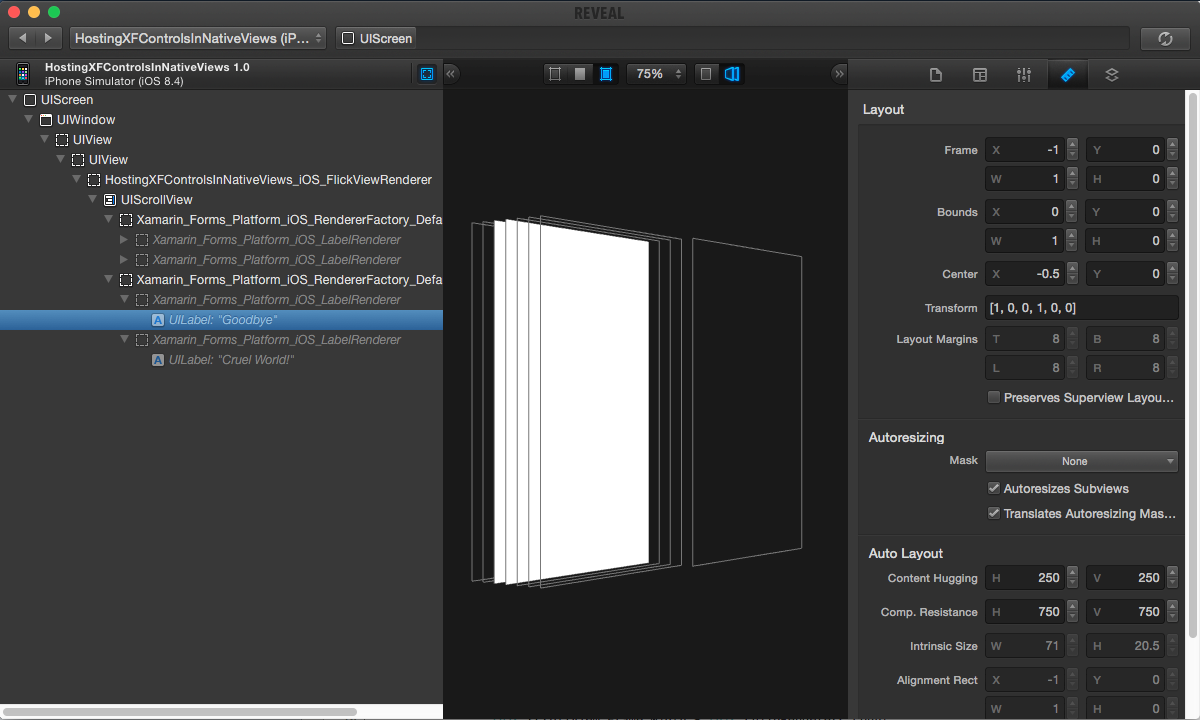Hosting Xamarin Forms Controls in Native Views
21 Jul 2015NOTE: the approach recommended in this blog post is based on Xamarin Forms 1.4.3.6376. If you’re using a newer version, it may be worth investigating whether the fundamental limitation discussed in this post has been addressed.
Recently I was working on a Xamarin Forms application and needed a control that acted as a container for other controls, and added behavior around that containment. There was nothing provided out of the box for the behavior I desired, so I resolved to writing my own.
For the purposes of this post, pretend I wanted a control that allows users to flick between any number of child controls. We might define it like this:
[ContentProperty("Children")]
public class FlickView : View, IViewContainer<View>
{
private readonly IList<View> children;
public FlickView()
{
this.children = new List<View>();
}
public IList<View> Children
{
get { return this.children; }
}
}
In the iOS renderer for our FlickView control, we’d like to place each child’s native view inside a UIScrollView. We would do so using code like this:
public class FlickViewRenderer : ViewRenderer<FlickView, UIView>
{
private UIScrollView scrollView;
private IList<IVisualElementRenderer> childRenderers;
protected override void OnElementChanged(ElementChangedEventArgs<FlickView> e)
{
base.OnElementChanged(e);
if (e.OldElement != null)
{
this.scrollView.Dispose();
foreach (var childRenderer in this.childRenderers)
{
childRenderer.NativeView.RemoveFromSuperview();
childRenderer.NativeView.Dispose();
childRenderer.Dispose();
}
}
if (e.NewElement != null)
{
this.scrollView = new UIScrollView
{
PagingEnabled = true,
ShowsHorizontalScrollIndicator = false,
ShowsVerticalScrollIndicator = false,
ScrollsToTop = false
};
this.childRenderers = e
.NewElement
.Children
.Select(RendererFactory.GetRenderer)
.ToList();
foreach (var childRenderer in this.childRenderers)
{
this.scrollView.AddSubview(childRenderer.NativeView);
}
this.SetNativeControl(this.scrollView);
}
}
public override void LayoutSubviews()
{
base.LayoutSubviews();
this.scrollView.Frame = this.Bounds;
this.scrollView.ContentSize = new CGSize(
this.scrollView.Frame.Width * this.childRenderers.Count,
this.scrollView.Frame.Height);
for (var i = 0; i < this.childRenderers.Count; ++i)
{
var childRenderer = this.childRenderers[i];
var childFrame = this.scrollView.Bounds;
childFrame.Offset(i * this.scrollView.Frame.Width, 0);
childRenderer.NativeView.Frame = childFrame;
childRenderer.Element.Layout(
new Rectangle(
0,
0,
this.Bounds.Width,
this.Bounds.Height));
}
}
}
Our renderer’s OnElementChanged method creates a UIScrollView with the necessary properties set so that it behaves in a page-like manner. It then gets renderers for each child, which allows us to bridge the gap between Xamarin Forms’ platform-agnostic control and a corresponding native iOS control. The native view exposed by each renderer is then added as a child view of the UIScrollView. Finally, a call to SetNativeControl is made against the renderer, passing in the UIScrollView we created.
The LayoutSubviews method assigns the bounds of the renderer to the UIScrollView, ensuring it occupies all available space. The ContentSize of the UIScrollView is set according to the number of child views, with the assumption that each child will take up the entire space occupied by the FlickControl. Then, the native view for each child has its Frame set such that each appears “one page” after the other in a horizontal strip. Finally, the Layout method is called against the renderer’s Xamarin Forms element so that it is aware of the space it is occupying.
With our control in place, we can define a quick UI with which to test it:
<?xml version="1.0" encoding="UTF-8"?>
<ContentPage
xmlns="http://xamarin.com/schemas/2014/forms"
xmlns:x="http://schemas.microsoft.com/winfx/2009/xaml"
xmlns:local="clr-namespace:HostingXFControlsInNativeViews"
x:Class="HostingXFControlsInNativeViews.MainPage">
<local:FlickView>
<Grid>
<Grid.RowDefinitions>
<RowDefinition Height="*"/>
<RowDefinition Height="Auto"/>
<RowDefinition Height="Auto"/>
<RowDefinition Height="*"/>
</Grid.RowDefinitions>
<Label Grid.Row="1" Text="Hello," HorizontalOptions="Center"/>
<Label Grid.Row="2" Text="World!" HorizontalOptions="Center"/>
</Grid>
<Grid>
<Grid.RowDefinitions>
<RowDefinition Height="*"/>
<RowDefinition Height="Auto"/>
<RowDefinition Height="Auto"/>
<RowDefinition Height="*"/>
</Grid.RowDefinitions>
<Label Grid.Row="1" Text="Goodbye" HorizontalOptions="Center"/>
<Label Grid.Row="2" Text="Cruel World!" HorizontalOptions="Center"/>
</Grid>
</local:FlickView>
</ContentPage>
If we start up an app using the above code, we see…precisely nothing. And if we use the excellent Reveal to take a peek at our visual tree, we can confirm why:

As you can see, our labels are in the visual tree, but their frames are set such that they are effectively hidden.
At this point in the process of writing my custom control I tried a dozen different code approaches, debugged for hours, and read countless forum posts and documentation pages. All of it was to no avail - I was simply stuck, seemingly doing everything I should reasonably need to do, but unable to get the child views to appear.
Over the course of a week or two, I exchanged several emails with Xamarin support. Eventually I was able to come up with a solution based on something the support engineer mentioned. It ain’t pretty, but it works.
The problem is that each Xamarin Forms element needs to know its platform. By that I mean it needs its Platform property set to an instance of IPlatform. Every Element has a Platform property for this purpose, but the problem is that it is currently internal. Until the fine folks at Xamarin see fit to open this API up to us plebs, this forces us to use reflection to solve our problem. In OnElementChanged we need to do this:
...
// HACK: we have to explicitly pass the platform through to each child element
var platformProperty = typeof(Element)
.GetProperty("Platform", BindingFlags.NonPublic | BindingFlags.Instance);
var platform = platformProperty
.GetValue(this.Element);
foreach (var childRenderer in this.childRenderers)
{
this.scrollView.AddSubview(childRenderer.NativeView);
// HACK: we have to explicitly pass the platform through to each child element
platformProperty.SetValue(childRenderer.Element, platform);
}
...
With this change hack in place, our child views now appear correctly:

You can download a working sample project here.